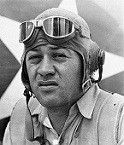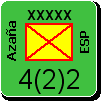brian brian
Posts: 3191
Joined: 11/16/2005
Status: offline

|
1. There are two kinds of bombers - LND (land), and NAV (naval). TRS is a transport, yes. I think these were mostly a short-hand unit type to use for printing set-ups as much as anything. They are handy in general.
2. I don't know the rule #s, but most likely in one of the first 3 rules covering the map there would be a diagram explaining the #s. Or it was printed on the map originally and now it is somewhere in the manuals.
The box numbers represent time. The more time a ship spends in a zone, the more effectively it can accomplish things. So a ship based near it's area of operations can spend more time on station than a ship that left port 1000 miles away. A Battleship berthed at Portsmouth on June 1st, 1944 can sail out and deliver Shore Bombardment over the beaches of Normandy much more effectively than one that found itself in New York on June 1st.
The higher the box # you select, the better chance you then have to find enemy forces when you look for them. Also, in a higher box, your forces suffer less from being surprised by the enemy.
The boxes also represent concentration and division of forces. One would think it would always be best to put each ship in the highest box possible. But at some times it might be better to concentrate your forces all in the same box, say to cover a troop convoy arriving from several zones distant. Or, you can split your units, with a Covering Force in a higher box that will be more effective in any potential combat, but might not necessarily be part of a combat with your Escorting Force. The enemy might get lucky and discover your Escorting Force on it's own, or you might get lucky and your Covering Force might discover the enemy and your Escorting Force can completely avoid them.
Each box # also has a "Shore Bombardment Modifier" that is subtracted from the Shore Bombardment factors of ships in lower boxes. This modifier is worsened by Rain and Snow weather.
|
 Printable Version
Printable Version








 you just did not want to say it
you just did not want to say it  I corrected myself in that post but anyway thank you.
I corrected myself in that post but anyway thank you.  New Messages
New Messages No New Messages
No New Messages Hot Topic w/ New Messages
Hot Topic w/ New Messages Hot Topic w/o New Messages
Hot Topic w/o New Messages Locked w/ New Messages
Locked w/ New Messages Locked w/o New Messages
Locked w/o New Messages Post New Thread
Post New Thread